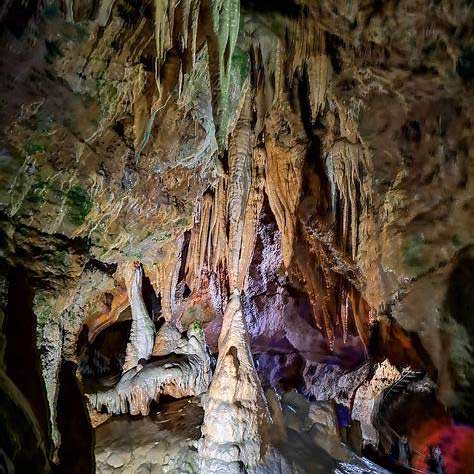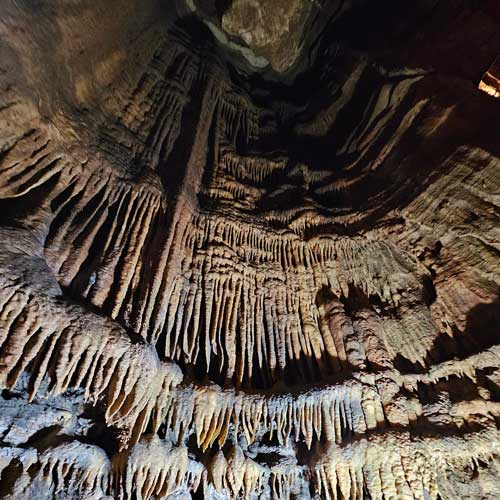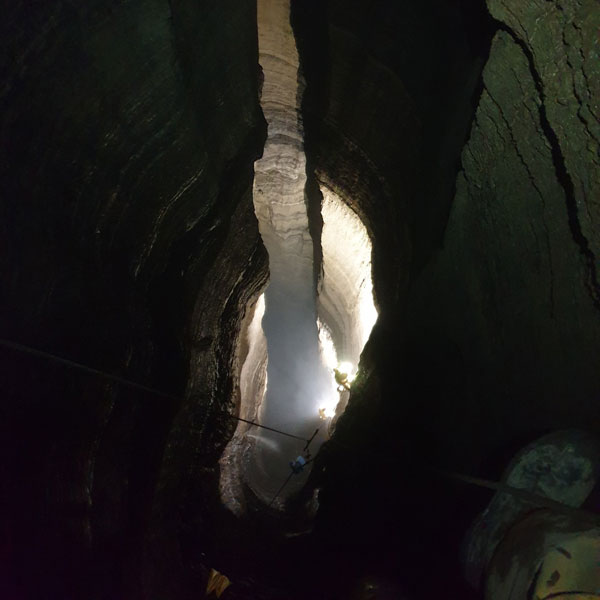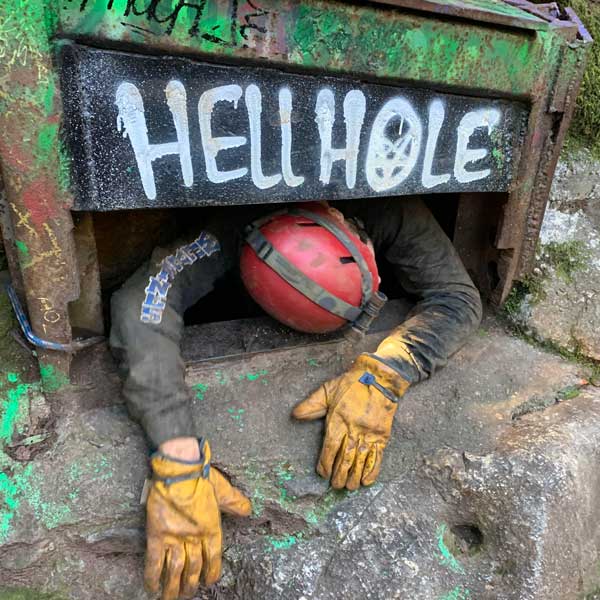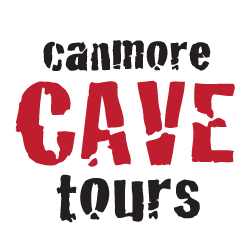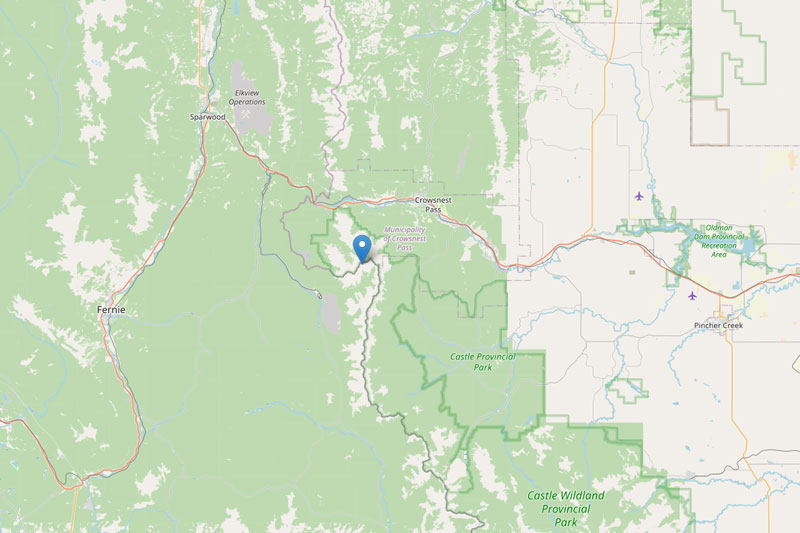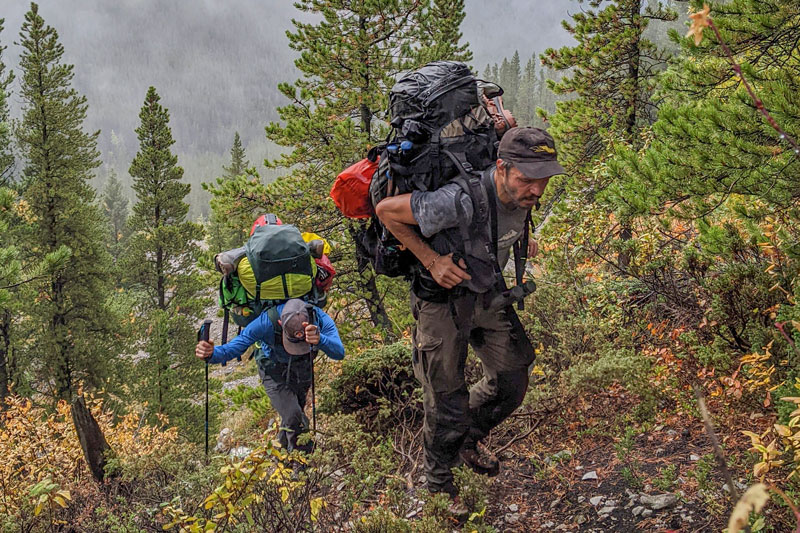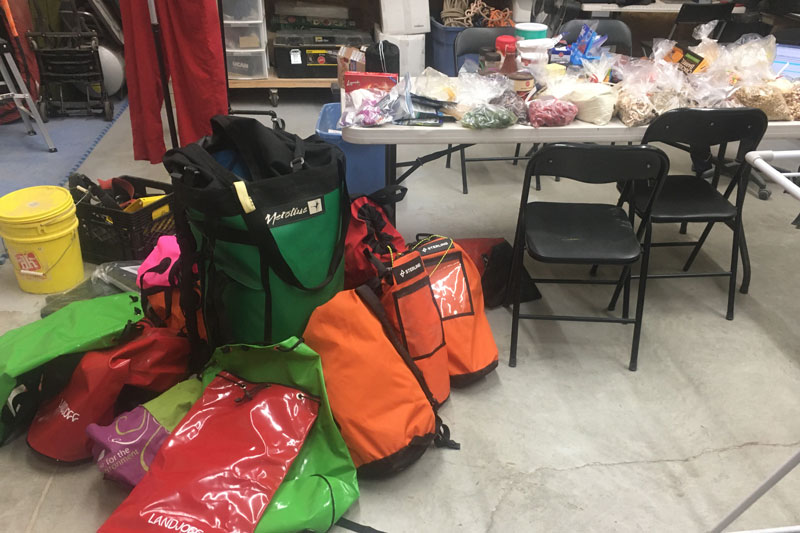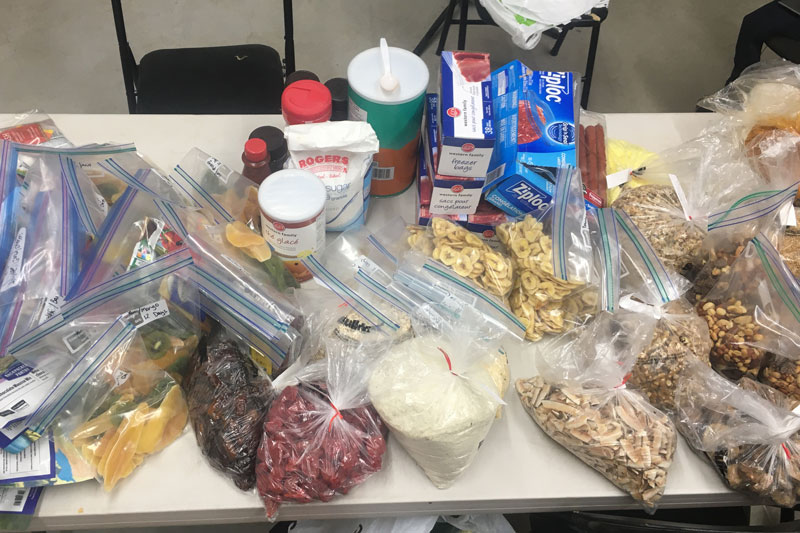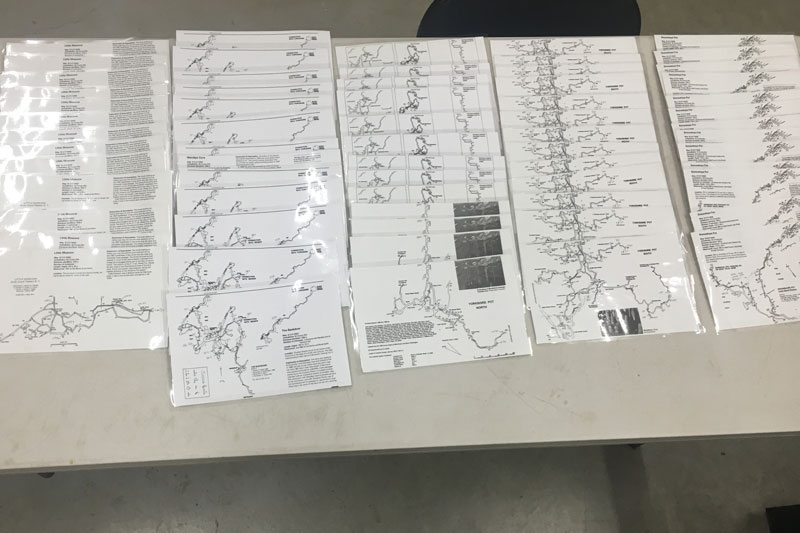[00:00:00] Adam: In September of this year, a group of cavers from Alberta and British Columbia embarked on an expedition to explore and continue the exploration of one of Canada's longest caves. Today, we have the expedition leader, Brent Arnold, joining us to tell us a little bit about the expedition and what they achieved during those ten days in the cave. Thanks, Brent, for joining us. I really appreciate having you here.
[00:00:36] Brent: Thanks, Adam, for having me today. Yorkshire Pot is currently Canada's third-longest cave and ninth-deepest cave. It’s located in the Crowsnest Pass on the Andigood Plateau. Exploration began back in 1969, and we’re continuing that journey, finding new places within the cave. It's been a dream of mine to discover more in Yorkshire Pot.
[00:01:05] Adam: Right. That’s a long time for a cave to be explored. How is there still anything left to discover?
[00:01:10] Brent: Over time, many of the passageways—being either very vertical, tight, or otherwise challenging—have been partially explored. People have focused on the main passageways, often spotting side passageways but leaving them unexplored. These are marked as "unexplored leads," and currently, there are about 140 of them still left in Yorkshire Pot.
[00:01:37] Adam: Wow, that’s a lot of potential. So, you mentioned it’s the third-longest cave in Canada. How long is it?
[00:01:43] Brent: As of now, it's 15 kilometers and 100 meters, thanks to the new exploration.
[00:01:48] Adam: That’s impressive! And this was achieved during your recent expedition?
[00:01:49] Brent: Yes, that’s correct. It’s a big cave, and it’s getting bigger.
[00:01:53] Adam: Organizing an expedition like this must be a significant undertaking. This isn’t your first time, though—you were in the cave a couple of years ago, right?
[00:01:59] Brent: Yes, in 2022, I ran a similar expedition. This is the second one I’ve led personally.
[00:02:05] Adam: I imagine you learned a lot from that experience. What goes into planning an expedition like this?
[00:02:19] Brent: Planning involves many components, such as assembling the right team, organizing food and equipment, and deciding how to transport everything. We had to consider whether to carry gear up or helicopter it in. For multi-day caving, we also needed camping equipment, hammer drills, bolts, and ropes to access new areas. Logistically, it’s a challenge, but it’s rewarding.
[00:02:57] Adam: What’s your background, and how did it lead you to caving and running expeditions like this?
[00:03:03] Brent: My journey began at Thompson Rivers University, where I completed an adventure guide degree focusing on mountaineering and rock climbing. I then discovered caving while working at Horn Lake Caves. After moving to Canmore, I’ve been with Canmore Cave Tours for nearly ten years. My experience in climbing, mountaineering, and guiding has equipped me with the skills needed for these expeditions.
[00:03:41] Adam: This was the first expedition you led yourself, aside from the one in 2022, right?
[00:03:50] Brent: Yes, I’ve joined other expeditions before, but this is the second one I’ve personally led.
[00:03:56] Adam: Awesome. I want to talk about what happened on the expedition, but let’s start with the planning and execution. This cave is in the alpine and not easy to access, correct?
[00:04:15] Brent: That’s right. It’s above the treeline, up in the alpine, and fairly remote.
[00:04:18] Adam: How did you transport your equipment to the cave?
[00:04:24] Brent: Most of the equipment was flown in by helicopter. It was placed in a bag hanging from the helicopter, which was released remotely onto the plateau. We then drove up a logging road, hiked for about two to three hours to reach the plateau, and set up camp near the entrance of Mendip’s Cave, one of the systems leading into Yorkshire Pot.
[00:04:51] Adam: Interesting! So, this cave has multiple entrances?
[00:04:55] Brent: Yes, there are currently seven entrances—or exits, depending on how you count them—leading into Yorkshire Pot.
[00:05:03] Adam: And so Mendip's is one of the entrances, right? Was it chosen for easier access to the cave, or was there another reason?
[00:05:09] Brent: It’s the flattest area we could find on the plateau, and it’s right outside the entrance. The main Yorkshire Pot entrance is only about 50 meters above it, so it’s pretty close to all the action.
[00:05:22] Adam: How big was your team for this year’s trip?
[00:05:25] Brent: Altogether, there were 15 people on the plateau at various times. We typically had seven or eight people there at a time, with others coming and going during the expedition.
[00:05:37] Adam: Right. I’ve been in the cave, and it’s not exactly spacious. It’s not a flat walking cave by any means—it’s very technical. Can you describe it a bit for those unfamiliar? And then let’s talk about what skills the group needs to participate in something like this.
[00:05:58] Brent: Yeah, you actually brought me into the cave for the first time! Yorkshire Pot is very vertical. From the main entrance, the first 200 meters are almost entirely vertical. It features tall, narrow rift passageways where you climb up and rappel down ropes, which are either pre-rigged or set up by us. The middle section involves crawling through keyhole-shaped passages, where the water has carved cylindrical spaces with deep chasms underneath. Finally, the lower section has seven more rappels before exiting through Heave Ho, a connected cave. The exit involves crawling through a hole reinforced with a garbage can to prevent it from collapsing.
[00:07:11] Adam: There’s probably a whole other story behind that garbage can! But it’s clearly a technical cave with a lot of ups and downs. As the expedition leader, what skills and traits were you looking for in your team?
[00:07:27] Brent: Personality is a big one. We needed people who could stay calm and collected under pressure and work well together. Caving can be very challenging. Beyond that, everyone had to be experienced cavers familiar with vertical caving techniques, specifically single rope technique (SRT). They also needed to know how to map and survey caves, using both traditional methods and advanced tools. If they were going to camp underground, they needed prior experience or at least comfort with the idea. Overall, we looked for people with the technical skills and willingness to face challenges head-on.
[00:08:29] Adam: So it’s not just about navigating the cave; there’s also the added layer of doing the work—surveying and exploring—on top of that. It sounds like a lot of effort.
[00:08:41] Brent: Absolutely. Surveying and exploring can be slow and arduous, but it’s an enjoyable process. The team needed diverse skills to handle everything involved.
[00:08:55] Adam: You mentioned camping in the cave. We’ve talked before about whether it’s more efficient to camp inside or make daily trips in and out. Building a camp inside a cave must be a huge undertaking. Why did you decide to camp, and what went into preparing for it?
[00:09:14] Brent: The decision depended on where we wanted to explore. We focused on areas like the Horror Show and the Rat Route, which are about 200 to 240 meters down. While descending can take just 45 minutes to an hour and a half for experienced cavers, adding gear like hammer drills, ropes, survey equipment, food, and warm layers significantly slows things down. Then, after finishing work at the bottom, you still have to climb out—a full trip could take 10 to 12 hours. Doing that back-to-back wasn’t feasible, so we chose to camp at the Chocolate Chamber. It’s at the bottom of the first entrance series, about 200 meters below the surface.
[00:10:35] Adam: Right. So camping saves you from having to repeatedly tackle the vertical sections of the cave, especially the climb back up after a long day of caving. That must be exhausting.
[00:10:44] Brent: Absolutely. You think you’re done, but then you have to climb back up all those ropes to the entrance. It’s a challenge.
[00:10:49] Adam: Walk us through how you plan for camping inside a cave. Most people can imagine camping on the surface, but what does a cave camp look like, and how do you prepare for it?
[00:11:00] Brent: The big differences with camping in a cave are that you never see sunlight, so you need to plan for light sources. We made sure to have plenty of batteries for headlamps and brought extra fairy lights to create some ambient light. The ground is uneven, so tents aren’t practical—they’re too big and bulky. Instead, we cleared flat spots by moving rocks aside to create three camping areas. We put a tarp down, followed by a Therm-a-Rest, a sleeping bag, and another tarp on top to protect against dripping water. Additionally, two people used hammocks set up with removable anchors. It’s all about adapting to the conditions underground.
[00:11:58] Adam: It sounds like an interesting, though maybe not entirely pleasant, sleeping experience. Hammocks can be divisive—some people love them, and some don’t.
[00:12:06] Brent: Exactly. Some people absolutely love sleeping in hammocks. Thankfully, the people who came on this expedition opted for the hammocks, leaving me happy to sleep on the ground. I’m not a hammock fan myself!
[00:12:22] Adam: Is there a difference in how you plan food for a surface camp versus a cave camp?
[00:12:28] Brent: For this expedition, the food was the same for both surface and cave camps. We used three-liter protein jugs filled with a mix of vermicelli noodles, potato flakes, beans, vegetable flakes, and spices. It was a sort of “Thai-ish” concoction. We also included oil with vitamin D and E for those camping inside the cave. Normally, on a backpacking trip, you’d use dehydrated meals, but since all the garbage has to be carried out of the cave, I opted for simpler meal prep this time.
[00:13:27] Adam: Speaking of logistics, one of the most common questions we get on tours is, "How do you go to the bathroom in a cave?" What does that process look like?
[00:13:36] Brent: It’s an awkward process, but it’s part of the planning. When designing a camping area in a cave, there are three main considerations: the sleeping area, a water source, and a waste management area. For urination, we aim to pee directly into flowing water to flush it out of the cave system quickly. If you just go in a corner, it builds up over time and becomes a problem. For solid waste, we use large Ziploc bags. You fold the edges, do your business, squeeze out the air (which is crucial), and seal it. The bags are then stored in a drum to be carried out of the cave. It’s not glamorous, but it works.
[00:14:37] Adam: It’s funny how talking about bathroom logistics underground feels so normal compared to the taboo above ground.
[00:14:46] Brent: Absolutely. It actually came up in almost every daily conversation during the expedition!
[00:14:52] Adam: So, you’ve got the camp set up, food prepared, and sleeping arrangements sorted. Let’s talk about the objectives. I’ve been fascinated by this cave for years, and with over 140 leads, there’s so much potential. But before we dive into this year’s expedition, tell us about what you accomplished in 2022.
[00:15:11] Brent: So in 2022, we were up there for 10 days. One of the main objectives was bolting the entire entrance series down to the Chocolate Chamber for SRT (single rope technique). Before that, the cave had been rigged and bolted for a through trip—from the top entrance to the Heave Ho exit. However, the ropes often touched rock edges, risking cuts and damage. Bolting made the system safer and more efficient for both access and egress, especially in the entrance sections.
[00:16:00] Brent: Another goal was to connect Little Moscow to the Yorkshire Pot system. It’s potentially the cave's highest entranceway and could add 50 to 80 meters of depth to the system if connected. Although we didn’t achieve this connection in 2022, it remains a key objective. We also aimed to resurvey and conduct new surveys in the Back Door, another entrance to the Yorkshire Pot system accessed through Mendip's Cave.
[00:16:52] Brent: Unexpectedly, we ended up collecting seven garbage bags of trash from the main entrance, Mendip's, and other small cave entrances on the plateau. Additionally, we discovered two troglobytic species—tiny cave-adapted animals living in the pools of water in the Horror Show section of the cave.
[00:17:08] Adam: These are cave-adapted animals?
[00:17:10] Brent: Yes, about the size of a speck of dust. One resembled a spider, and the other looked a bit like the Michelin Man. They were incredibly small, almost tardigrade-like. Matt Kennedy and Lewis noticed them while having a snack near a pool of water.
[00:17:39] Adam: And you also did some surveying?
[00:17:40] Brent: Yes, we added to the survey of the Back Door and rebolted the entrance series of Yorkshire Pot. We also discovered new entrances on the plateau and created a more accurate survey of the connection between Mendip's and the Back Door. However, much of the effort focused on bolting and surveying in the Horror Show. That’s when we realized how challenging it would be to do back-to-back trips in that section.
[00:18:19] Adam: What were the objectives for the 2024 expedition?
[00:18:23] Brent: In 2024, we aimed to connect the Little Moscow system, which we didn’t achieve in 2022. We also planned to establish a camp in the Chocolate Chamber to support ongoing surveys of the Horror Show and the Rat Route. Additionally, we focused on creating more accurate surveys of Mendip's and the Yorkshire main entrance.
[00:18:59] Adam: How did it go?
[00:19:00] Brent: Overall, it went well. We surveyed another 850 meters of cave—thanks to the entire team. We rebolted new sections at the bottom of the Chocolate Chamber and established a station to support future surveys. While we didn’t survey as much as anticipated in some areas, we set up infrastructure for continued exploration.
[00:19:34] Adam: Let’s talk about the surveying process. Walk us through, in simple terms, how cave surveys are conducted so people can visualize it.
[00:19:46] Brent: Sure. A cave survey essentially creates a line plot of the cave. We start by identifying a point on the wall, floor, or ceiling and marking it with something visible, like nail polish. Then, we move to a point further along the path that’s visible from the first point and mark that. We measure the distance between these two points and the azimuth—the direction in degrees, such as 120 or 130 degrees, indicating the north-south-east-west orientation.
[00:20:26] Adam: The compass bearing, basically?
[00:20:27] Brent: The compass bearing, yeah, and also the slope using a clinometer. Nowadays, we use a DISTO X, which is a laser pointer that gives us all these measurements. Essentially, we’re creating a line plot from point to point. We also measure the distance from the left wall to the right wall, the ceiling, and the floor to determine the passage size around each point. Then we repeat that process thousands of times until we’ve mapped the cave.
[00:20:56] Adam: That’s a lot of work. But there’s also someone sketching the details as you go, right?
[00:21:01] Brent: Yes, while one person collects measurements, another is sketching—either on paper or a device. They’ll document details like cave formations, floor composition, and the distances between walls. They also create both a top-down plan view and a side profile of the cave map.
[00:21:28] Adam: That’s a lot of effort. I think there’s a misconception that we just use some advanced technology to map the cave instantly, but every detail on a cave map is created by someone physically being there, right?
[00:21:41] Brent: Exactly. Here in the Rockies, if you can survey 300 meters in a day, that’s considered a very productive day. The vertical nature of the caves makes the process even more challenging.
[00:21:48] Adam: The verticality definitely adds complexity to the process.
[00:21:52] Brent: It does. But modern tools like the DISTO X2 and BRICS, which are essentially laser pointers, have revolutionized our work. Pairing these with a phone via Bluetooth creates incredibly accurate maps. We can now measure things like the height of a roof in a passageway, which previously had to be estimated. This reduces errors significantly.
[00:22:26] Adam: That’s a huge improvement. You mentioned you had around ten people at a time on this expedition. Did you break into smaller teams to tackle different objectives?
[00:22:39] Brent: Absolutely. We typically worked in teams of two to four. At most, six people were in the cave at one time. We’d often split into two groups—one group would survey in one area, while the other surveyed or bolted in another. On the surface, teams also had their own objectives, such as exploring or surveying cave entrances. The group needed to be self-driven and adaptable.
[00:23:27] Adam: Did you find anything exciting this year? In 2022, you discovered those troglophiles.
[00:23:36] Brent: The most interesting find this year was a camera at the bottom of the cave. We found squishy light bulbs, camera pieces, and an ammo canister in a section below the Chocolate Chamber. It was neat to link that to survey files referring to the area as the "camera section." On the surface, a few team members cleaned nine garbage bags of trash from a cave now nicknamed "Garbage Cave." They found everything from baby bottles to diapers, food bags, and even an old aluminum helmet, which was pretty cool.
[00:24:42] Adam: That’s incredible, especially considering how remote these caves are—it’s at least a three-hour hike just to get there!
[00:24:45] Brent: Exactly. It’s quite a hike. But as for new discoveries, there wasn’t as much in 2024. The new survey of Mendip’s Cave, however, was fascinating. According to previous maps, the cave was roughly 316 meters long, but Christian, Matt Kennedy, and Cynthia surveyed close to 800 meters in a section thought to be only 50 to 75 meters. That’s a significant find and suggests there may be even more unexplored passages than the 140 leads we already know about.
[00:25:33] Adam: Yeah, I mean, a big takeaway from our earlier conversations is that you went in with 140 leads, and you came out with more than 140.
[00:25:41] Brent: So many more. Every time we took measurements, we found discrepancies compared to previous surveys. For example, one rappel was previously measured at 15 meters, but we found it to be closer to 18 meters. If these kinds of adjustments continue throughout the cave, it could ultimately make the cave longer and deeper than currently documented.
[00:26:07] Adam: So you did some surveying but didn’t manage to connect Little Moscow this year?
[00:26:11] Brent: No, Little Moscow is still eluding us. I’m not even sure if we’re looking in the right place, or if the cavers of yesteryear were better at squeezing through tight spots, or if the cave has changed due to collapses or other factors. We’ll need to go back and keep trying to locate and connect it.
[00:26:26] Adam: That’s an interesting point. The plateau has changed significantly in the last decade with snow and ice loss. You’ve already discovered new passages and entrances, and I imagine that could lead to even more significant discoveries in the coming years.
[00:26:47] Brent: Absolutely. On future expeditions, one of our goals will be to mark the entranceways of the caves with metal tags and their names. We’d like to create a database of the Andigood Plateau caves—it’s essentially Swiss cheese up there with so many holes to document.
[00:27:11] Adam: That sounds like a productive trip. But the big question is, why do you do it? What’s the point?
[00:27:19] Brent: That’s a great question. For me, it’s about exploration—pushing myself physically and mentally to see new places. But beyond personal reasons, these expeditions also contribute to better knowledge and safety for future cavers by providing more accurate maps and information. This enables safer access to these environments. On a broader scale, it helps us understand geological processes, such as how glaciers interacted with the plateaus, eroding the rock to create these caves. It’s about exploring the unknown and contributing to our understanding of the natural world.
[00:28:34] Adam: Right, it’s fun and challenging, but it also has scientific and environmental benefits. Discovering new species and understanding these caves—which are essentially natural plumbing systems—are critical for protecting groundwater and learning how these systems function.
[00:28:53] Brent: Exactly. Understanding these caves helps us figure out how to protect them and the resources they’re connected to. It also helps us piece together the story of how they were formed.
[00:29:00] Adam: So, what’s next? You’ve mentioned another expedition. Are you planning to head back?
[00:29:06] Brent: Yes, likely. We left much of our camping gear inside the cave—stored in 20-liter olive drums—including sleeping bags, Therm-a-Rests, first aid supplies, and extra food. I’d love to return to the Horror Show and continue mapping there. One of my long-term goals is to resurvey the entire through trip of this cave. It’s a classic route and arguably the best through trip in Canada. Resurveying it would give us a solid baseline for future explorations. Additionally, marking the cave entrances on the plateau and updating the database will be significant objectives. Combining old survey data with new data can be challenging, especially when the old data is less accurate, but it’s important work.
[00:30:25] Adam: Right. So when you start getting loops, you have to close them, and any potential error can throw everything off.
[00:30:30] Brent: Exactly, and there are a lot of loops in Yorkshire Pot. Closing them accurately is crucial, which is why redoing the survey is important. Another priority is bolting the Seven Steps, a series of rappels at the bottom of the cave. The Super Dip Way has already been bolted, but the Seven Steps hasn’t. On an earlier trip, ropes were wrapped around rocks there, and now they’re slightly calcified in place.
[00:31:02] Adam: A bit of a seat-of-our-pants approach on that one.
[00:31:03] Brent: Yeah, definitely. I’d love to rebuild that section. It’s a beautiful part of the cave, and having a safer access point would encourage more people to explore it without feeling like they’re taking unnecessary risks. There’s still so much to explore, particularly near Heave Ho’s exit, where the map shows a lot of dotted lines indicating unexplored areas. I feel like I could spend a lifetime in Yorkshire Pot and still not see all of it.
[00:31:35] Adam: So why hasn’t this incredible cave been fully explored?
[00:31:40] Brent: It’s hard to say. One joke in the caving community is that creating a through trip is the death of exploration. When Heave Ho was connected to Yorkshire Pot—making it a through trip—it became more appealing for cavers to simply do the trip rather than spend time surveying and mapping. It shifted from adding to the cave’s knowledge to just enjoying the caving experience, like the difference between bolting a rock climb versus climbing it.
[00:32:27] Adam: And once the "easy" parts are done, the remaining work is often more challenging. Plus, new expeditions and objectives pop up that might be more exciting or accessible, drawing attention away from caves like Yorkshire Pot.
[00:32:45] Brent: Exactly. For example, we have the deepest cave in Canada, Bisaro Anima, just a few hours away. It’s understandable why resources and attention get redirected. Yorkshire Pot deserves more focus, but there are only so many cavers with the necessary skills.
[00:33:00] Adam: And there’s also a distinct shortage of experienced cavers.
[00:33:04] Brent: Absolutely. During COVID, our club’s membership increased by over 100%, but even now, we have maybe just over 200 members. That’s not a lot of people to pull from, especially for expeditions requiring specific skills. It’s still a challenge to build a strong caving community in Canada.
[00:33:35] Adam: How can people get involved in caving and work toward joining expeditions like this?
[00:33:38] Brent: The best way is to join your local caving club, whether you’re in Alberta, BC, or elsewhere. Most provinces and territories have at least a small group of cavers. Joining a club lets you connect with experienced cavers who can mentor you. You’ll start with small horizontal caves, then progress to learning rope skills, like SRT (single rope technique), for vertical caving. If you’re interested in expeditions, you’ll need to learn surveying, sketching, and mapping. And don’t underestimate the importance of physical fitness—hauling 30 to 40-pound bags through tight spaces is a big part of caving expeditions.
[00:34:39] Adam: That’s a big part of it—dragging heavy bags through very small spaces.
[00:34:45] Brent: Exactly. Sometimes you’re pulling gear behind you, clipped to your harness, through mud and water. Then there are the vertical pitches, which can be stunningly beautiful. If you have a climbing background or are willing to start learning SRT through online resources or courses, it’s a great way to get started. Joining a club and beginning the mentorship process is the best first step.
[00:35:22] Adam: But as you mentioned, mentorship is really important, right? Every cave is different, and you need judgment and experience to navigate them safely.
[00:35:30] Brent: Absolutely. Finding those mentors is a critical step. They’ll guide you through the skills and knowledge you need to cave safely and effectively.
[00:35:36] Adam: Awesome. And through the caving clubs, that’s how you access expeditions like this, right?
[00:35:41] Brent: Exactly. That’s where we post information about upcoming expeditions, how many people we’re looking for, and the details on how to get involved. Just keep asking and staying connected with the community, and eventually, you’ll have the chance to join an expedition and see some truly beautiful places.
[00:35:57] Adam: That’s awesome. It sounds like this was a really productive and effective expedition. Congratulations.
[00:36:02] Brent: Thank you very much.
[00:36:03] Adam: Thanks for all the effort you put into this. Congratulations again. I know there were a lot of people and organizations involved in supporting this expedition. Would you like to give a shoutout to anyone in particular?
[00:36:14] Brent: Absolutely. The Royal Canadian Geographical Society was a huge help—they provided significant monetary support. I’d also like to thank all the cavers who joined, not just for the 2024 expedition, but also for the 2022 one. They’re the ones who make this possible; I just try to rally the group together. You’ve also been a wealth of knowledge, so thank you for that. There are many people I’d like to thank, and most of them know who they are, but the financial backing from organizations like the RCGS is particularly invaluable. Logistically, these expeditions are tough to fund, and their support was crucial for the 2024 expedition.
[00:37:02] Adam: Great. I wish you the best of luck with your next expedition, and I look forward to hearing about it. Thanks again for joining us.
[00:37:09] Brent: Thank you.


